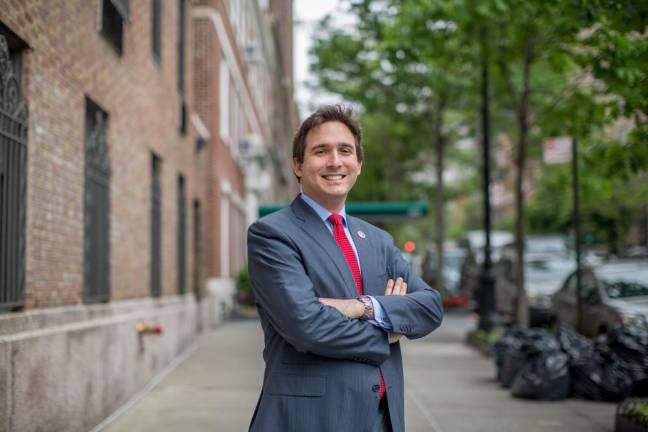City Planning Commission Approves Blood Center Project
Opponents vow to fight on as plan goes next to the City Council


The controversial proposal to build a 340-foot life sciences laboratory and office tower on the current site of The New York Blood Center’s three story East Side headquarters has been tossed to the City Council for decision.
That is the political impact of the project’s approval Wednesday by the City Planning Commission, which split 8 votes in favor and 2 against.
The commission majority sided with supporters who said the tower, far larger than current zoning allows, is necessary to generate the funds needed to replace the antiquated Blood Center and to support the city’s larger effort to make New York a capital of biotech.
One planning commissioner, Orlando Marin of the Bronx, said he was voting yes even though the tower would be “taller than what it should be” in a “normal” midblock project. “This is a Blood Center that is necessary for the City of New York,” he explained.
But the two dissenters sided with the strong community resistance. The dissenters were Alfred C. Cerullo, a Staten Island Republican and CEO of the Grand Central Partnership, and Anna Hayes Levin, appointee of the Manhattan Borough president, Gale Brewer, who has urged the plan be scaled back.
“I am disappointed in the decision made by the NYC Planning Commission and I urge the NYC Council to make the changes to the application that I have called for,” Brewer said. “I believe that the Blood Center can still have a modern facility that is shorter and more contextual that meets their needs while respecting the neighborhood.”
The Blood Center hailed the Planning Commission vote.
“This is exactly the project our city needs right now,” said Rob Purvis, The Blood Center’s Executive Vice President and Chief of Staff. “Our vision for a state-of-the-art life science facility will not only ensure the nonprofit Blood Center continues to provide safe, affordable blood services to the region’s hospitals, but enable the center to significantly expand its life-saving research on COVID-19 and blood-related diseases in collaboration with institutions and biotechnology partners all under the same roof.”
The building trades and employment groups are supporting the Blood Center.
Community Opposition
But opponents vowed to fight on in the City Council.
“Rarely has the community been so united on an issue as they have been in opposition to this proposal,” said the chair of the community board, Russell Squire. “Community Board 8 will continue to stand with the community and fight this proposal.”
Both the City Council member representing the Upper East Side district, Ben Kallos, and his likely successor, Julie Menin, Democratic nominee for the seat, have strongly opposed the project.
“There are numerous life sciences corridors that would be a perfect alternative for this project,” Menin said in a statement. “As this project heads to the City Council, I urge the Council to stand with Council Member Kallos and vote no on this project.”
Generally, council members give deference to the views of a member on projects in his or her district. “Will council member deference hold?” asked a city official who opposes the project. “Some central staff want to see it go through.”
The project is the latest example of the clash between development and local communities. The East Side opponents say the tower, which would rise on 67th Street between First and Second Avenues, will be too large and cast a deep shadow over a neighboring park. It would be a breach, they argue, of a zoning rule that has prevented such “mid-block” development on the East Side for two generations.
Fundamentally, they argue the project is a commercial development under cover of the Blood Center’s not-for-profit status. About one third of the space would be for the Blood Center’s new facilities and the remainder would be leased by the commercial developer, Longfellow Real Estate Partners, to biotech firms and others in the health sciences.
“What the Blood Center and Longfellow Real Estate Partners are asking for is a subsidy,” Brewer wrote to the Planning Commission in her case against the proposal.
An opposition group formed by residents of a nearby apartment building, East Siders for Responsible Zoning, accused the planning commission of “a failure to listen to the community and the facts of this scheme,” including that there was already more than enough life science space in development to serve the city’s needs.
“Despite all this, instead of taking a real look at the application, CPC decided to rubber stamp this project with just one addition – installing a Citi Bike rack on the block, which is already too congested with school and MTA buses running on it, as well as the ambulances going to emergencies from Memorial Sloan Kettering.”
But supporters have characterized the opponents as “NIMBYists” and argued the city’s greater good is served by the project, known as Center East.
“Center East will position New York to be a life science innovation hub, create jobs, stimulate billions in economic output annually, and open career opportunities for local students and young professionals,” said Purvis of the Blood Center.
“Rarely has the community been so united on an issue as they have been in opposition to this proposal. Community Board 8 will continue to stand with the community and fight this proposal.” Russell Squire, chair of CB 8